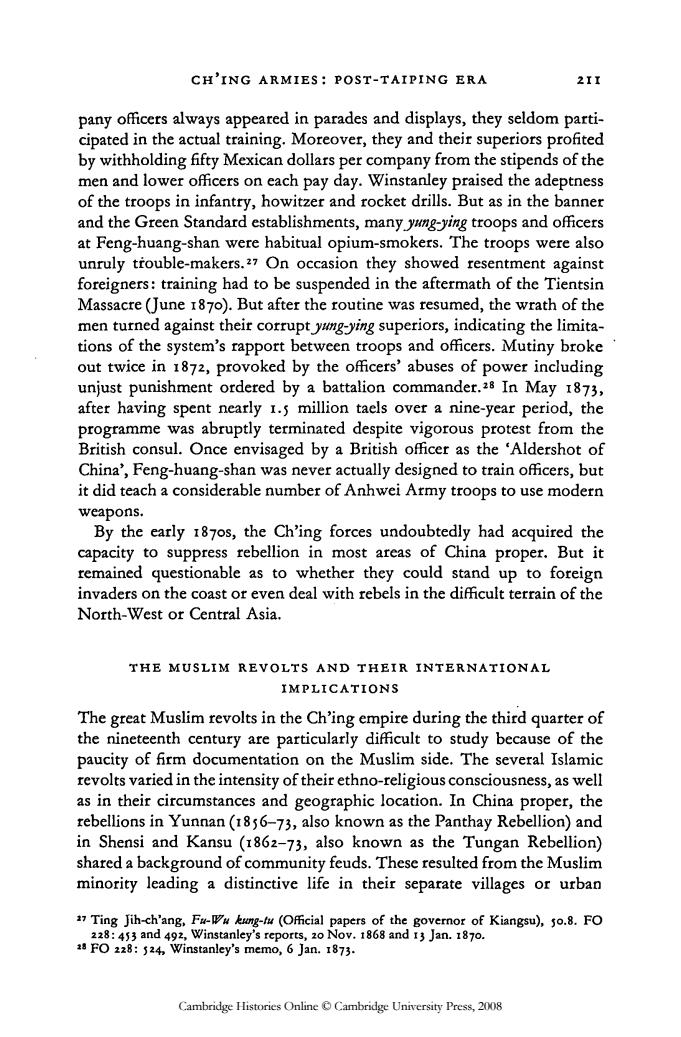正在加载图片...

CH'ING ARMIES:POST-TAIPING ERA 2II pany officers always appeared in parades and displays,they seldom parti- cipated in the actual training.Moreover,they and their superiors profited by withholding fifty Mexican dollars per company from the stipends of the men and lower officers on each pay day.Winstanley praised the adeptness of the troops in infantry,howitzer and rocket drills.But as in the banner and the Green Standard establishments,many yung-ying troops and officers at Feng-huang-shan were habitual opium-smokers.The troops were also unruly tiouble-makers.27 On occasion they showed resentment against foreigners:training had to be suspended in the aftermath of the Tientsin Massacre(June I87o).But after the routine was resumed,the wrath of the men turned against their corrupt yimg-ying superiors,indicating the limita- tions of the system's rapport between troops and officers.Mutiny broke out twice in 1872,provoked by the officers'abuses of power including unjust punishment ordered by a battalion commander.In May 1873, after having spent nearly 1.5 million taels over a nine-year period,the programme was abruptly terminated despite vigorous protest from the British consul.Once envisaged by a British officer as the 'Aldershot of China',Feng-huang-shan was never actually designed to train officers,but it did teach a considerable number of Anhwei Army troops to use modern weapons. By the early 187os,the Ch'ing forces undoubtedly had acquired the capacity to suppress rebellion in most areas of China proper.But it remained questionable as to whether they could stand up to foreign invaders on the coast or even deal with rebels in the difficult terrain of the North-West or Central Asia. THE MUSLIM REVOLTS AND THEIR INTERNATIONAL IMPLICATIONS The great Muslim revolts in the Ch'ing empire during the third quarter of the nineteenth century are particularly difficult to study because of the paucity of firm documentation on the Muslim side.The several Islamic revolts varied in the intensity of their ethno-religious consciousness,as well as in their circumstances and geographic location.In China proper,the rebellions in Yunnan(1856-73,also known as the Panthay Rebellion)and in Shensi and Kansu (1862-73,also known as the Tungan Rebellion) shared a background of community feuds.These resulted from the Muslim minority leading a distinctive life in their separate villages or urban 7 Ting Jih-ch'ang,Fa-Wu kung-tu (Official papers of the governor of Kiangsu),5o.8.FO 228:453 and 49z,Winstanley's reports,zo Nov.1868 and 13 Jan.1870. a FO 228:524,Winstanley's memo,6 Jan.1873. Cambridge Histories Online Cambridge University Press,2008CH'iNG ARMIES: POST-TAIPING ERA 211 pany officers always appeared in parades and displays, they seldom participated in the actual training. Moreover, they and their superiors profited by withholding fifty Mexican dollars per company from the stipends of the men and lower officers on each pay day. Winstanley praised the adeptness of the troops in infantry, howitzer and rocket drills. But as in the banner and the Green Standard establishments, many yung-ying troops and officers at Feng-huang-shan were habitual opium-smokers. The troops were also unruly trouble-makers.27 On occasion they showed resentment against foreigners: training had to be suspended in the aftermath of the Tientsin Massacre (June 1870). But after the routine was resumed, the wrath of the men turned against their corruptyung-ying superiors, indicating the limitations of the system's rapport between troops and officers. Mutiny broke out twice in 1872, provoked by the officers' abuses of power including unjust punishment ordered by a battalion commander.28 In May 1873, after having spent nearly 1.5 million taels over a nine-year period, the programme was abruptly terminated despite vigorous protest from the British consul. Once envisaged by a British officer as the 'Aldershot of China', Feng-huang-shan was never actually designed to train officers, but it did teach a considerable number of Anhwei Army troops to use modern weapons. By the early 1870s, the Ch'ing forces undoubtedly had acquired the capacity to suppress rebellion in most areas of China proper. But it remained questionable as to whether they could stand up to foreign invaders on the coast or even deal with rebels in the difficult terrain of the North-West or Central Asia. THE MUSLIM REVOLTS AND THEIR INTERNATIONAL IMPLICATIONS The great Muslim revolts in the Ch'ing empire during the third quarter of the nineteenth century are particularly difficult to study because of the paucity of firm documentation on the Muslim side. The several Islamic revolts varied in the intensity of their ethno-religious consciousness, as well as in their circumstances and geographic location. In China proper, the rebellions in Yunnan (1856-73, also known as the Panthay Rebellion) and in Shensi and Kansu (1862-73, also known as the Tungan Rebellion) shared a background of community feuds. These resulted from the Muslim minority leading a distinctive life in their separate villages or urban 17 Ting Jih-ch'ang, Fu-Wu kung-fu (Official papers of the governor of Kiangsu), 50.8. FO 228: 455 and 492, Winstanley's reports, 20 Nov. 1868 and IJ Jan. 1870. " FO 228: 524, Winstanley's memo, 6 Jan. 1873. Cambridge Histories Online © Cambridge University Press, 2008